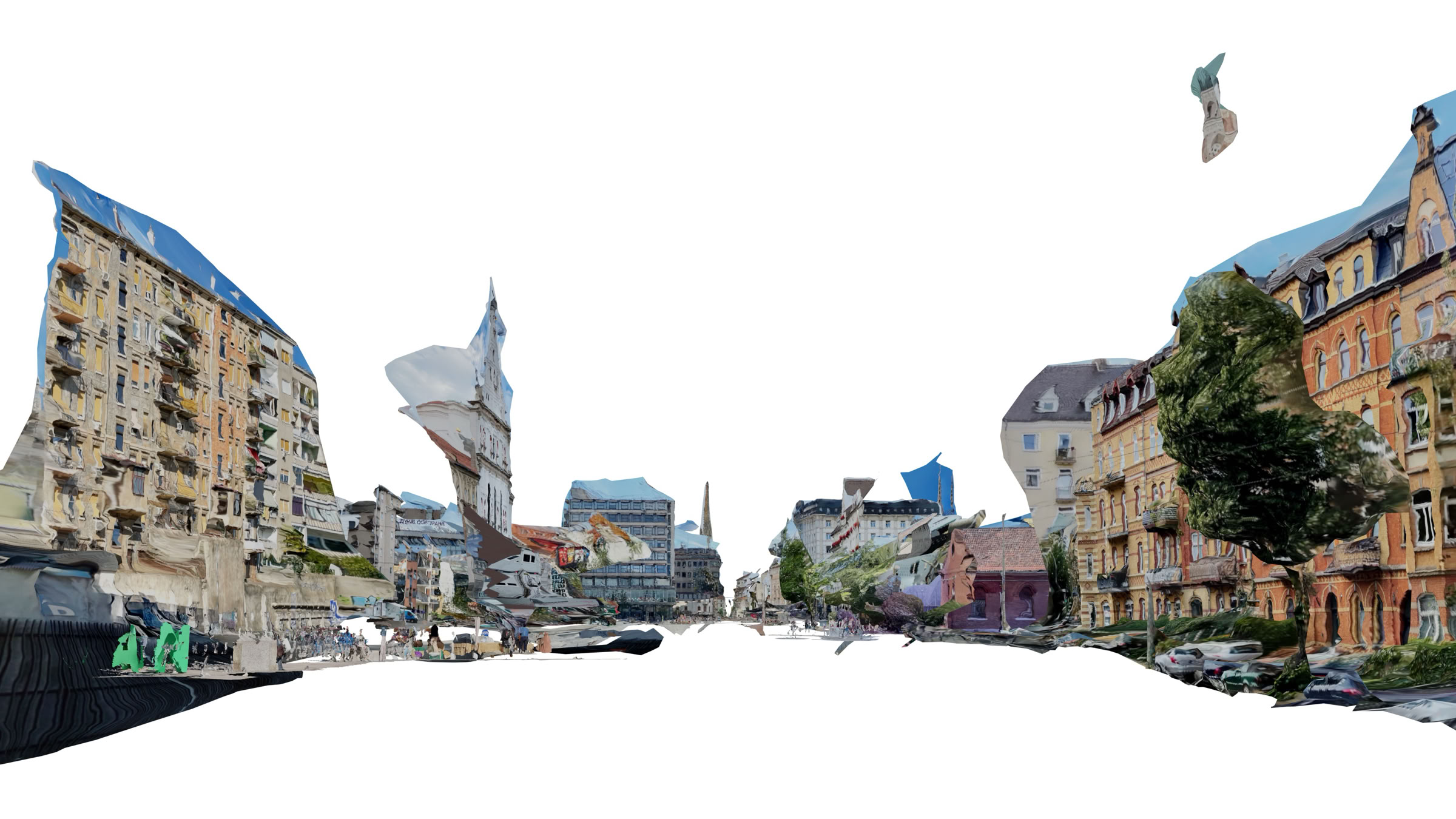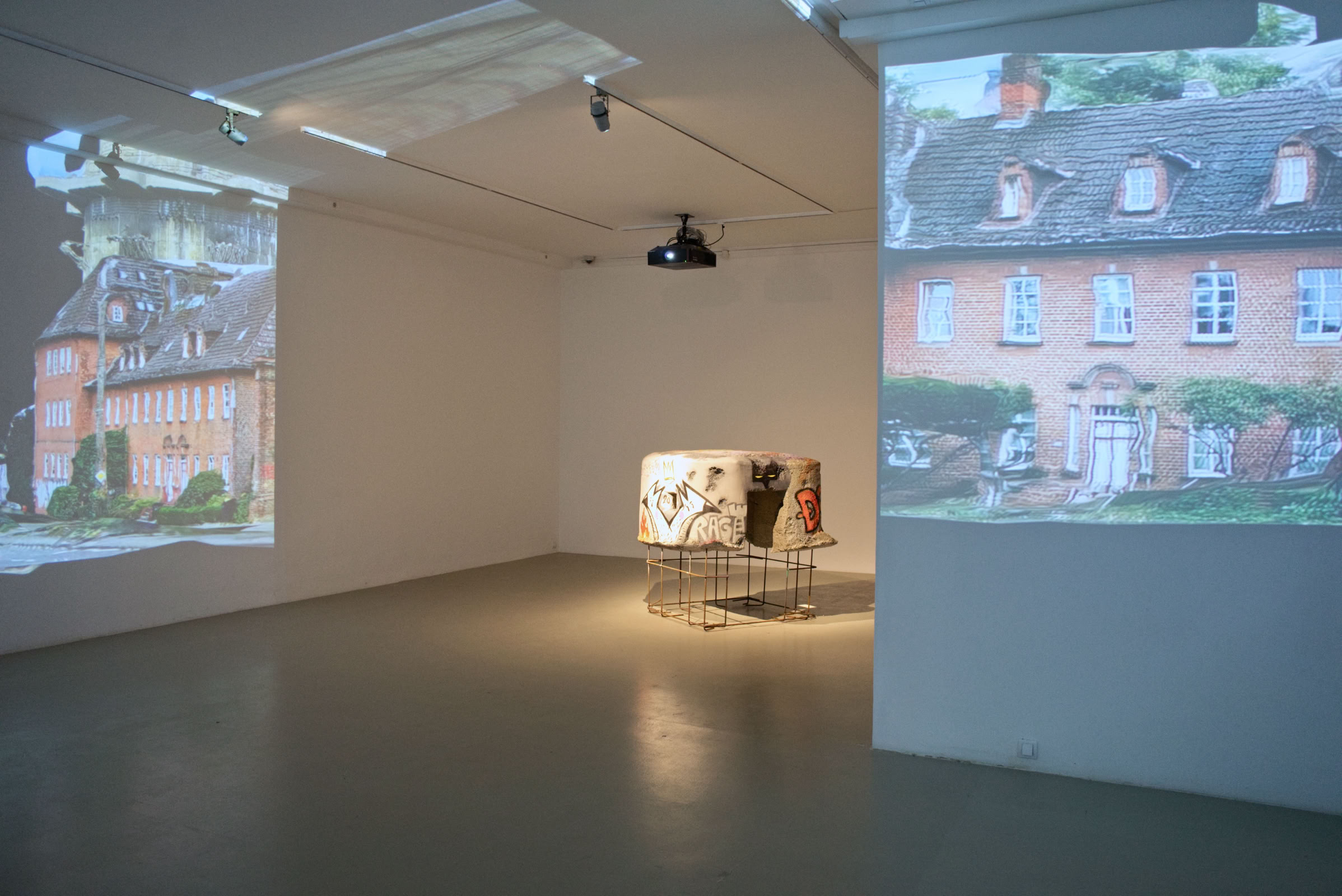Safe in Nemanja Ladjic’s Safe Distance
by Maja Stankovic
It seems that we are well into a post-Covid world. We are still afraid of the Covid virus, but it is slowly transitioning from a threatening disease to the ordinary flu. However, not so long ago, the Covid pandemic was a threat that loomed over our lives and became an integral part of our everyday reality. That reality twisted and writhed under the weight of the pandemic, crushing us from all sides, narrowing the space of our activities and the scope of our thinking, fixing it to the fear of a tiny cell-less organism lurking everywhere. We used to fear people who looked threatening; now, we are getting used to the fact that every man approaching us is a potential threat because he could be a transmitter of danger. We had to articulate that fear somehow and resist it. Our strategic response was to introduce a safe distance.
Corona threw us into a distance: from people, meetings, socializing and touch. However, in the post-Covid world, we are slowly starting to resist, to push it out of our environment or pretend not to see it. The coronavirus also tied us to our screens. They have long been part of our furniture, paving the way for our daily migrations from the real to the virtual world of images and back. At one time, in the not-so-distant past, during the days of “lockdown,” they became the dominant reality for the majority – or minority! – of those who had the privilege to protect ourselves by moving out of the usual workspace into our own four walls. Even though we are in a hurry to turn it into the seasonal flu as soon as possible, the Covid pandemic has changed, initiated, produced a series of situations – safe distance being only one of them – allowing us to see it as a kind of cut in the social fabric, accompanied by acute disturbances in the body of the society and the individual, which are still present. Žižek would say that the pandemic is just a dress rehearsal for a global state of emergency. It could also be observed as a dress rehearsal for our repeatedly delayed full entry into the virtual space. Nemanja Lađić’s exhibition titled Safe Distance problematizes exactly that process: an introduction to the grand finale of the transition from the screen to the virtual space.

The exhibition is spatially divided into three conceptually and spatially connected segments. In the central part of the gallery is a total installation that uses visual and sound images to cover the entire space: six projections composed of photo scans processed in 3D modelling software are positioned in a series to simulate the appearance of a street in an urban environment. It also simulates movement, as the still images in the projections are set in motion, which creates the illusion of moving between real and virtual space. At the same time, the viewers find themselves in a perverted situation of horizontal scrolling, which proceeds against their will and occasionally causes dizziness. This scroll includes randomly connected pictures from various places, from known and unknown locations – Belgrade, Vienna, Venice, etc. The first impression is that we are immersed in someone’s intimate world, filled with impressions and fragments of memories, in which we move along predetermined paths. After some time, we become an integral part of that mental journey.
However, this first reflective layer of the work simultaneously introduces us to the next. After some time, we discern that the simulation of real space is broken, fragmented, as empty, abstract spaces occasionally interrupt the lines of continuity that connect these series of images. The function of this imperfect, discontinuous simulation is to break the illusion of wholeness and to indicate that we are surrounded not only by fragments of pictures but also by information, noises, records and signs. This movement through a forest of signs calls to mind one of the early digital works, which somehow introduces us to the digital paradigm and virtual space – Jeffrey Show’s Legible City (1991). In this work, the street is composed of letters, words and inscriptions. In it, we are seminauts roaming through a world of signs. This world is animated and graphically determined, with clear boundaries to the real world. On the contrary, in the work of Nemanja Lađić, clear boundaries between real and virtual no longer exist; they have become fluid and extensible, so we find ourselves moving through worlds that intertwine mutually: the subjective world, the real world, the world of information or post-information, the virtual world, the world of signs, media, film, etc., and with the opening frames from Jarmusch’s movies Down the Law (1986) and Stranger Than Paradise (1984).
It is an unstable, unsafe, fluctuating and fragmented post-world built from the real, analog and virtual, from traces of old memories, remembered landscapes, personal impressions, information and misinformation. In addition to the reflective and the informative, another layer of the work seems to reveal itself, which shows, predicts, warns of or announces the possibility of a new world in the near future, both (un) real and (non)virtual, comprised of post-apocalyptic, post-nuclear and post-dystopian scenes and created on the remains of the ruined Western world. Maybe we already live in such a world. The images surrounding us are simultaneously introspective, retrospective and prospective: they appear, change and depart from us, but they do not lead us to the future, keeping us in the past instead. The past and the future overlap in the same way as the real and virtual spaces we are in, leaving us in a loop. The loop of the sound images that follow us further highlights this impression. Is the past too present in our lives, with its old, worn-out narratives, outgrown Cold War divisions and retrograde motions? Does it obscure the future or has the future become un- thinkable, a belated category reduced to a minute to midnight? Or is the loop “time- less” – a “total present” in which the moment “has given way to a click” (Hahn)?

This loop, suggested in the space using images and sounds, seems to most accurately diagnose the moment we live in: we have the impression that we are moving, but we are, in fact, closed in a virtual space of images, cliched narratives inherited from the previous century and the fake information that sustains them. A direct reference to this closed quality – even as a scale model, painted with colourful graffiti – is the bunker we reach when we pass through the virtual street. The installation with balloons we first encounter at the entrance to the gallery also suggests an enclosure. It attracts and fixes our attention: it seems daring and fun because it defies the laws of the physical world, so we “don’t see” or pay no attention to the fact that it is in a closed box-like space. It is similar to our experience of the virtual world. That world offers the possibility of liberation from the physical; it allows us to float freely in a new, airless, generated space filled with images, sounds, data. However, we are also closed there: in inflated info balloons, in familiar framing, with resistance to thinking. The balloon and the bunker at the beginning and the end, or the new beginning, outline the paradox in which we find ourselves: the balloon is a symbol of lightness, playfulness, weightlessness, but also limitation, just like the bunker, a survival machine (Virilio). The bunker also refers to external pressure, acute danger and the need for immediate protection due to the possibility of complete disintegration of our, until yesterday, safe and familiar world.
Translated by Maja Vojvodić Jovanović